Application of Knowledge: Nursing Program Assignment - Semester 2
VerifiedAdded on 2023/01/10
|9
|2663
|34
Homework Assignment
AI Summary
This assignment is a comprehensive exploration of applying knowledge within a nursing context, specifically tailored for a graduate nurse program. It begins with a self-reflection section, where the student analyzes a chosen program, discussing personal attributes and how they align with the program's key features. The assignment then moves into a clinical scenario, detailing immediate actions and rationales for patient care when encountering a patient experiencing seizures. The core of the assignment involves patient prioritization, where the student evaluates four distinct patient cases, categorizing them based on urgency and justifying the order of medical attention. Finally, the assignment delves into a professional scenario, analyzing a conflict between a nurse and a Resident Medical Officer (RMO) and applying conflict resolution and communication skills to manage the situation effectively. The student references various research papers to support their arguments, demonstrating a solid understanding of nursing principles and practices.
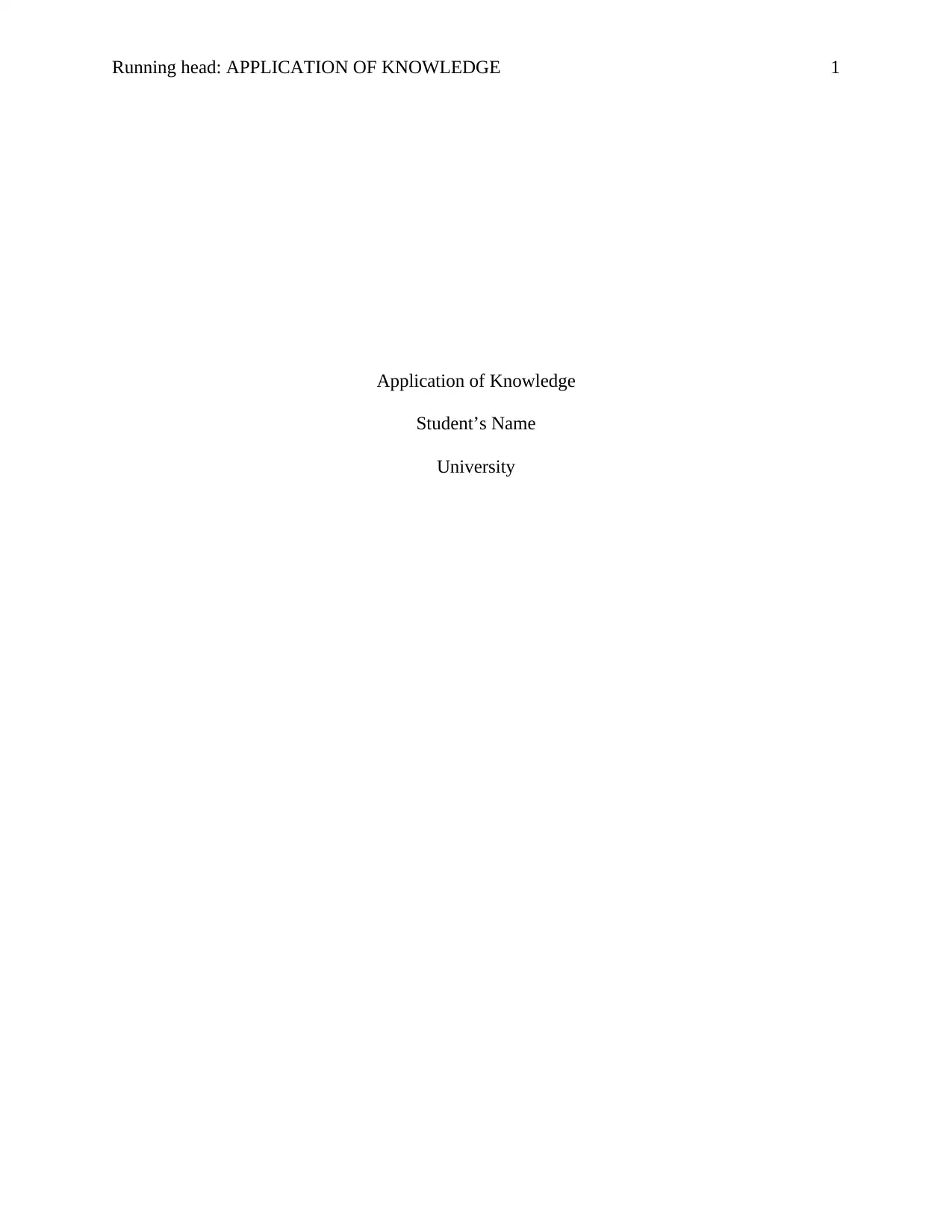
Running head: APPLICATION OF KNOWLEDGE 1
Application of Knowledge
Student’s Name
University
Application of Knowledge
Student’s Name
University
Paraphrase This Document
Need a fresh take? Get an instant paraphrase of this document with our AI Paraphraser
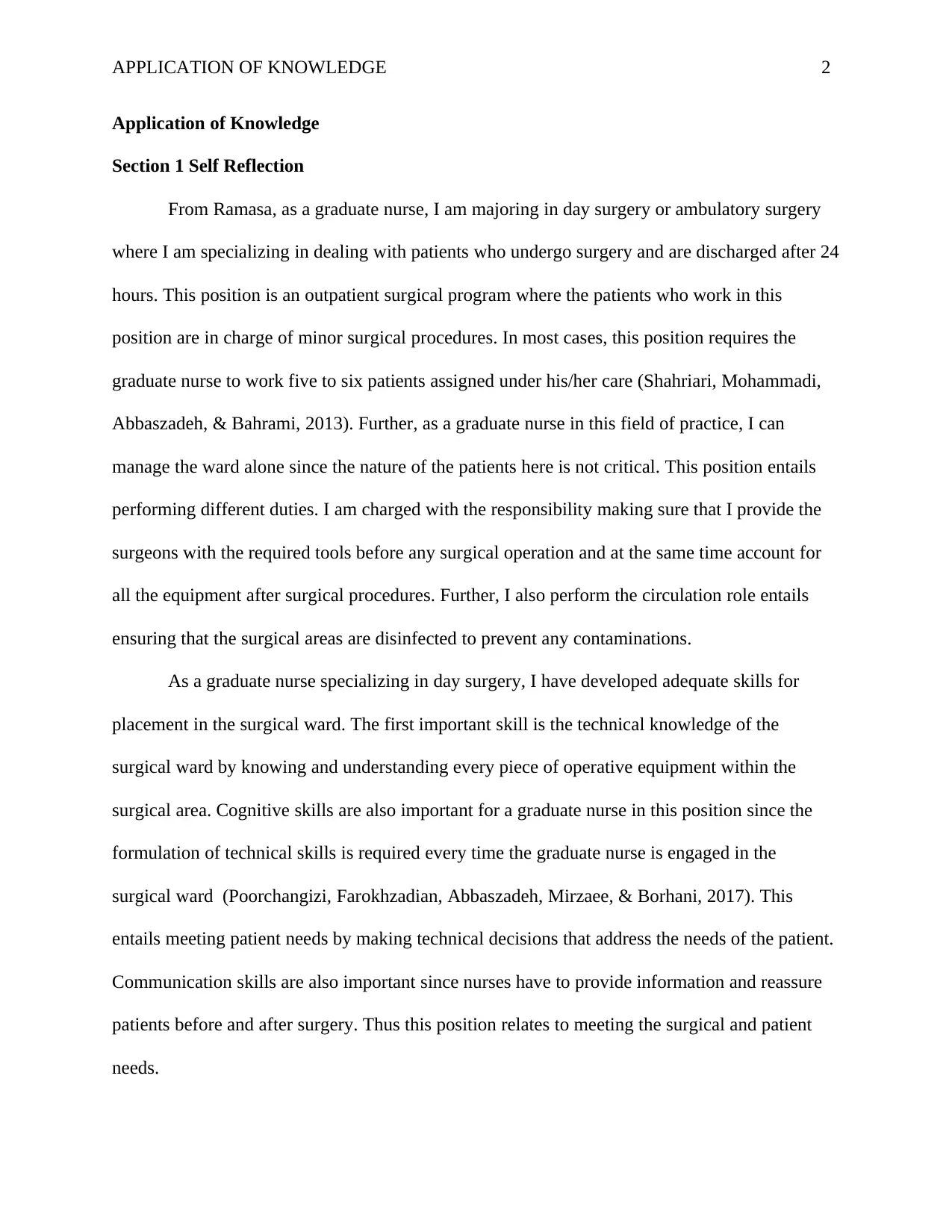
APPLICATION OF KNOWLEDGE 2
Application of Knowledge
Section 1 Self Reflection
From Ramasa, as a graduate nurse, I am majoring in day surgery or ambulatory surgery
where I am specializing in dealing with patients who undergo surgery and are discharged after 24
hours. This position is an outpatient surgical program where the patients who work in this
position are in charge of minor surgical procedures. In most cases, this position requires the
graduate nurse to work five to six patients assigned under his/her care (Shahriari, Mohammadi,
Abbaszadeh, & Bahrami, 2013). Further, as a graduate nurse in this field of practice, I can
manage the ward alone since the nature of the patients here is not critical. This position entails
performing different duties. I am charged with the responsibility making sure that I provide the
surgeons with the required tools before any surgical operation and at the same time account for
all the equipment after surgical procedures. Further, I also perform the circulation role entails
ensuring that the surgical areas are disinfected to prevent any contaminations.
As a graduate nurse specializing in day surgery, I have developed adequate skills for
placement in the surgical ward. The first important skill is the technical knowledge of the
surgical ward by knowing and understanding every piece of operative equipment within the
surgical area. Cognitive skills are also important for a graduate nurse in this position since the
formulation of technical skills is required every time the graduate nurse is engaged in the
surgical ward (Poorchangizi, Farokhzadian, Abbaszadeh, Mirzaee, & Borhani, 2017). This
entails meeting patient needs by making technical decisions that address the needs of the patient.
Communication skills are also important since nurses have to provide information and reassure
patients before and after surgery. Thus this position relates to meeting the surgical and patient
needs.
Application of Knowledge
Section 1 Self Reflection
From Ramasa, as a graduate nurse, I am majoring in day surgery or ambulatory surgery
where I am specializing in dealing with patients who undergo surgery and are discharged after 24
hours. This position is an outpatient surgical program where the patients who work in this
position are in charge of minor surgical procedures. In most cases, this position requires the
graduate nurse to work five to six patients assigned under his/her care (Shahriari, Mohammadi,
Abbaszadeh, & Bahrami, 2013). Further, as a graduate nurse in this field of practice, I can
manage the ward alone since the nature of the patients here is not critical. This position entails
performing different duties. I am charged with the responsibility making sure that I provide the
surgeons with the required tools before any surgical operation and at the same time account for
all the equipment after surgical procedures. Further, I also perform the circulation role entails
ensuring that the surgical areas are disinfected to prevent any contaminations.
As a graduate nurse specializing in day surgery, I have developed adequate skills for
placement in the surgical ward. The first important skill is the technical knowledge of the
surgical ward by knowing and understanding every piece of operative equipment within the
surgical area. Cognitive skills are also important for a graduate nurse in this position since the
formulation of technical skills is required every time the graduate nurse is engaged in the
surgical ward (Poorchangizi, Farokhzadian, Abbaszadeh, Mirzaee, & Borhani, 2017). This
entails meeting patient needs by making technical decisions that address the needs of the patient.
Communication skills are also important since nurses have to provide information and reassure
patients before and after surgery. Thus this position relates to meeting the surgical and patient
needs.
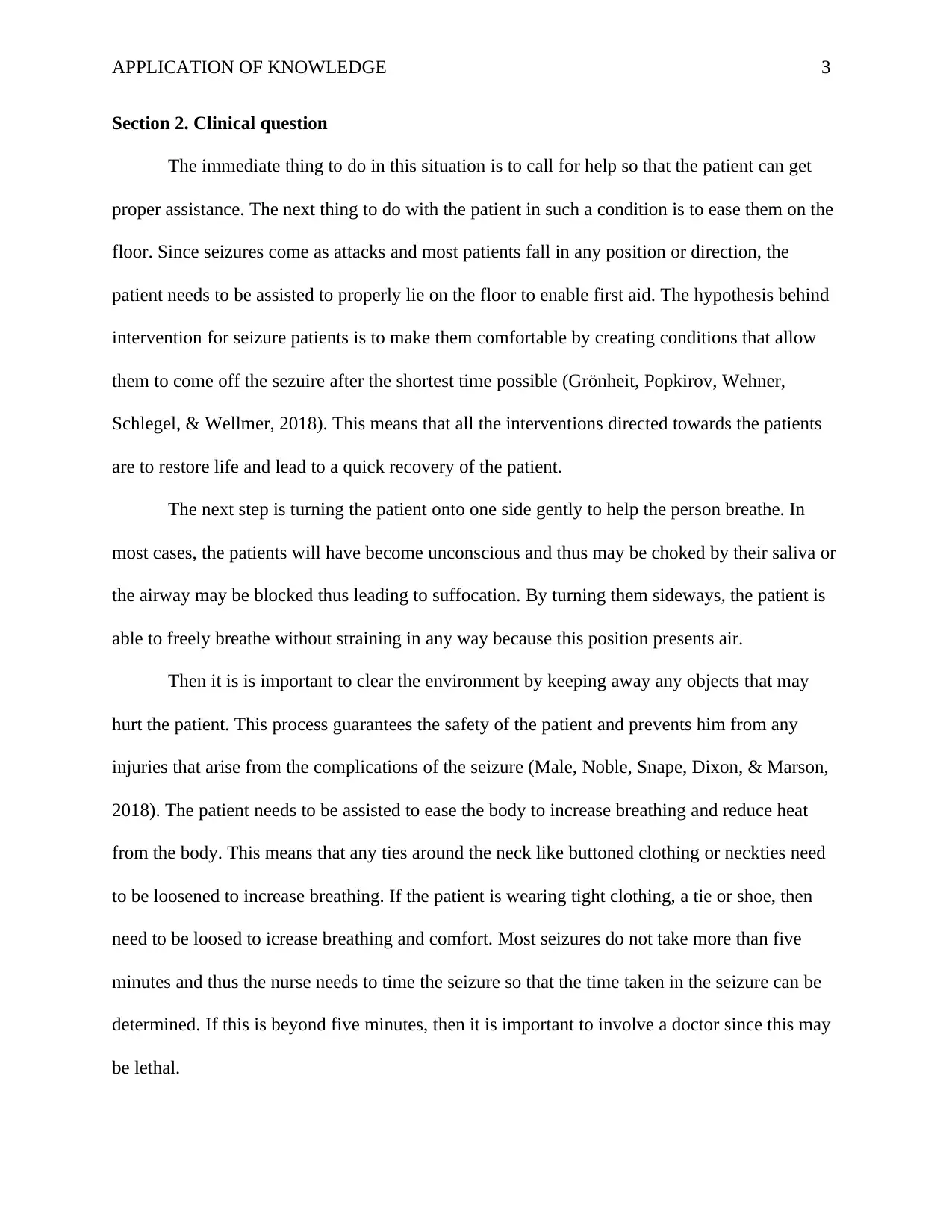
APPLICATION OF KNOWLEDGE 3
Section 2. Clinical question
The immediate thing to do in this situation is to call for help so that the patient can get
proper assistance. The next thing to do with the patient in such a condition is to ease them on the
floor. Since seizures come as attacks and most patients fall in any position or direction, the
patient needs to be assisted to properly lie on the floor to enable first aid. The hypothesis behind
intervention for seizure patients is to make them comfortable by creating conditions that allow
them to come off the sezuire after the shortest time possible (Grönheit, Popkirov, Wehner,
Schlegel, & Wellmer, 2018). This means that all the interventions directed towards the patients
are to restore life and lead to a quick recovery of the patient.
The next step is turning the patient onto one side gently to help the person breathe. In
most cases, the patients will have become unconscious and thus may be choked by their saliva or
the airway may be blocked thus leading to suffocation. By turning them sideways, the patient is
able to freely breathe without straining in any way because this position presents air.
Then it is is important to clear the environment by keeping away any objects that may
hurt the patient. This process guarantees the safety of the patient and prevents him from any
injuries that arise from the complications of the seizure (Male, Noble, Snape, Dixon, & Marson,
2018). The patient needs to be assisted to ease the body to increase breathing and reduce heat
from the body. This means that any ties around the neck like buttoned clothing or neckties need
to be loosened to increase breathing. If the patient is wearing tight clothing, a tie or shoe, then
need to be loosed to icrease breathing and comfort. Most seizures do not take more than five
minutes and thus the nurse needs to time the seizure so that the time taken in the seizure can be
determined. If this is beyond five minutes, then it is important to involve a doctor since this may
be lethal.
Section 2. Clinical question
The immediate thing to do in this situation is to call for help so that the patient can get
proper assistance. The next thing to do with the patient in such a condition is to ease them on the
floor. Since seizures come as attacks and most patients fall in any position or direction, the
patient needs to be assisted to properly lie on the floor to enable first aid. The hypothesis behind
intervention for seizure patients is to make them comfortable by creating conditions that allow
them to come off the sezuire after the shortest time possible (Grönheit, Popkirov, Wehner,
Schlegel, & Wellmer, 2018). This means that all the interventions directed towards the patients
are to restore life and lead to a quick recovery of the patient.
The next step is turning the patient onto one side gently to help the person breathe. In
most cases, the patients will have become unconscious and thus may be choked by their saliva or
the airway may be blocked thus leading to suffocation. By turning them sideways, the patient is
able to freely breathe without straining in any way because this position presents air.
Then it is is important to clear the environment by keeping away any objects that may
hurt the patient. This process guarantees the safety of the patient and prevents him from any
injuries that arise from the complications of the seizure (Male, Noble, Snape, Dixon, & Marson,
2018). The patient needs to be assisted to ease the body to increase breathing and reduce heat
from the body. This means that any ties around the neck like buttoned clothing or neckties need
to be loosened to increase breathing. If the patient is wearing tight clothing, a tie or shoe, then
need to be loosed to icrease breathing and comfort. Most seizures do not take more than five
minutes and thus the nurse needs to time the seizure so that the time taken in the seizure can be
determined. If this is beyond five minutes, then it is important to involve a doctor since this may
be lethal.
⊘ This is a preview!⊘
Do you want full access?
Subscribe today to unlock all pages.

Trusted by 1+ million students worldwide
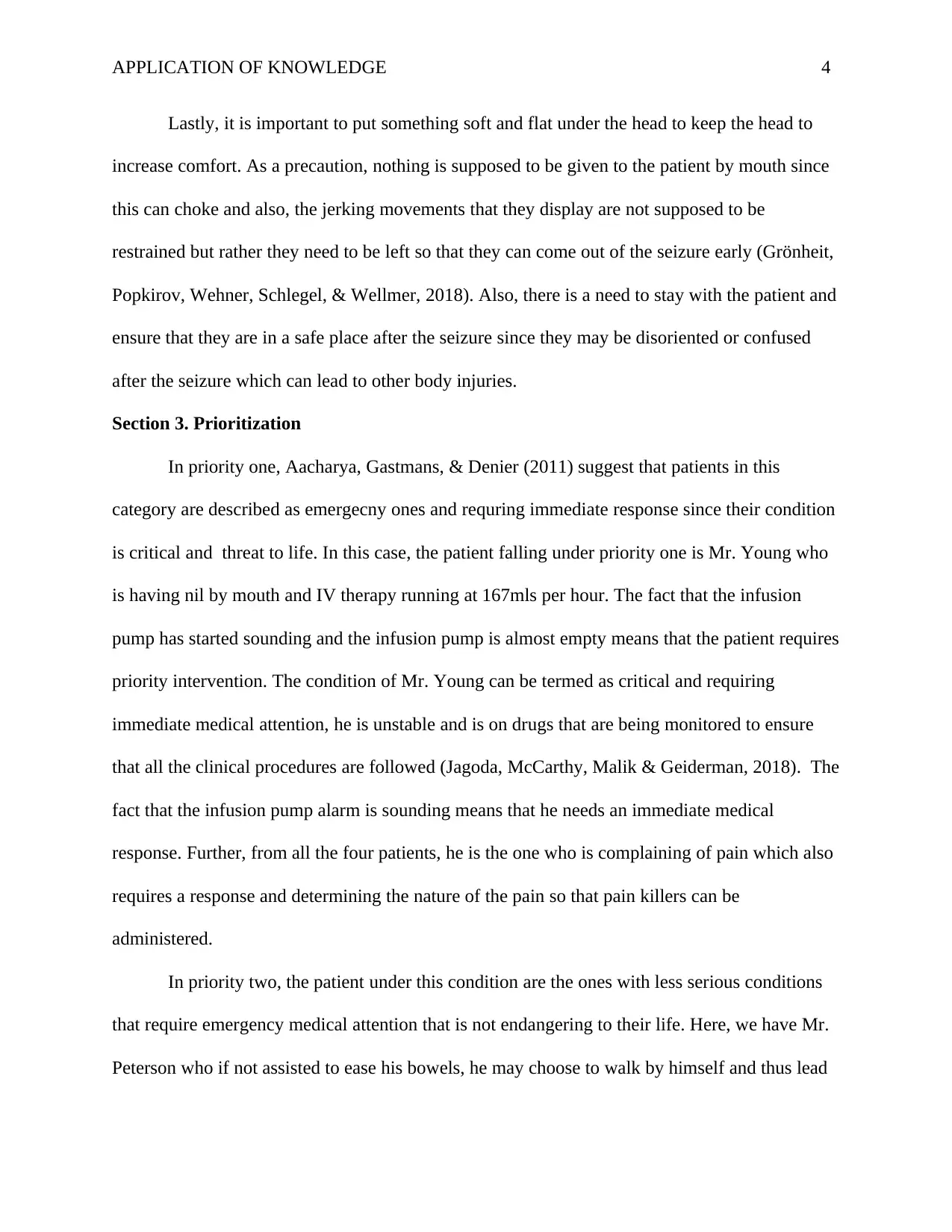
APPLICATION OF KNOWLEDGE 4
Lastly, it is important to put something soft and flat under the head to keep the head to
increase comfort. As a precaution, nothing is supposed to be given to the patient by mouth since
this can choke and also, the jerking movements that they display are not supposed to be
restrained but rather they need to be left so that they can come out of the seizure early (Grönheit,
Popkirov, Wehner, Schlegel, & Wellmer, 2018). Also, there is a need to stay with the patient and
ensure that they are in a safe place after the seizure since they may be disoriented or confused
after the seizure which can lead to other body injuries.
Section 3. Prioritization
In priority one, Aacharya, Gastmans, & Denier (2011) suggest that patients in this
category are described as emergecny ones and requring immediate response since their condition
is critical and threat to life. In this case, the patient falling under priority one is Mr. Young who
is having nil by mouth and IV therapy running at 167mls per hour. The fact that the infusion
pump has started sounding and the infusion pump is almost empty means that the patient requires
priority intervention. The condition of Mr. Young can be termed as critical and requiring
immediate medical attention, he is unstable and is on drugs that are being monitored to ensure
that all the clinical procedures are followed (Jagoda, McCarthy, Malik & Geiderman, 2018). The
fact that the infusion pump alarm is sounding means that he needs an immediate medical
response. Further, from all the four patients, he is the one who is complaining of pain which also
requires a response and determining the nature of the pain so that pain killers can be
administered.
In priority two, the patient under this condition are the ones with less serious conditions
that require emergency medical attention that is not endangering to their life. Here, we have Mr.
Peterson who if not assisted to ease his bowels, he may choose to walk by himself and thus lead
Lastly, it is important to put something soft and flat under the head to keep the head to
increase comfort. As a precaution, nothing is supposed to be given to the patient by mouth since
this can choke and also, the jerking movements that they display are not supposed to be
restrained but rather they need to be left so that they can come out of the seizure early (Grönheit,
Popkirov, Wehner, Schlegel, & Wellmer, 2018). Also, there is a need to stay with the patient and
ensure that they are in a safe place after the seizure since they may be disoriented or confused
after the seizure which can lead to other body injuries.
Section 3. Prioritization
In priority one, Aacharya, Gastmans, & Denier (2011) suggest that patients in this
category are described as emergecny ones and requring immediate response since their condition
is critical and threat to life. In this case, the patient falling under priority one is Mr. Young who
is having nil by mouth and IV therapy running at 167mls per hour. The fact that the infusion
pump has started sounding and the infusion pump is almost empty means that the patient requires
priority intervention. The condition of Mr. Young can be termed as critical and requiring
immediate medical attention, he is unstable and is on drugs that are being monitored to ensure
that all the clinical procedures are followed (Jagoda, McCarthy, Malik & Geiderman, 2018). The
fact that the infusion pump alarm is sounding means that he needs an immediate medical
response. Further, from all the four patients, he is the one who is complaining of pain which also
requires a response and determining the nature of the pain so that pain killers can be
administered.
In priority two, the patient under this condition are the ones with less serious conditions
that require emergency medical attention that is not endangering to their life. Here, we have Mr.
Peterson who if not assisted to ease his bowels, he may choose to walk by himself and thus lead
Paraphrase This Document
Need a fresh take? Get an instant paraphrase of this document with our AI Paraphraser
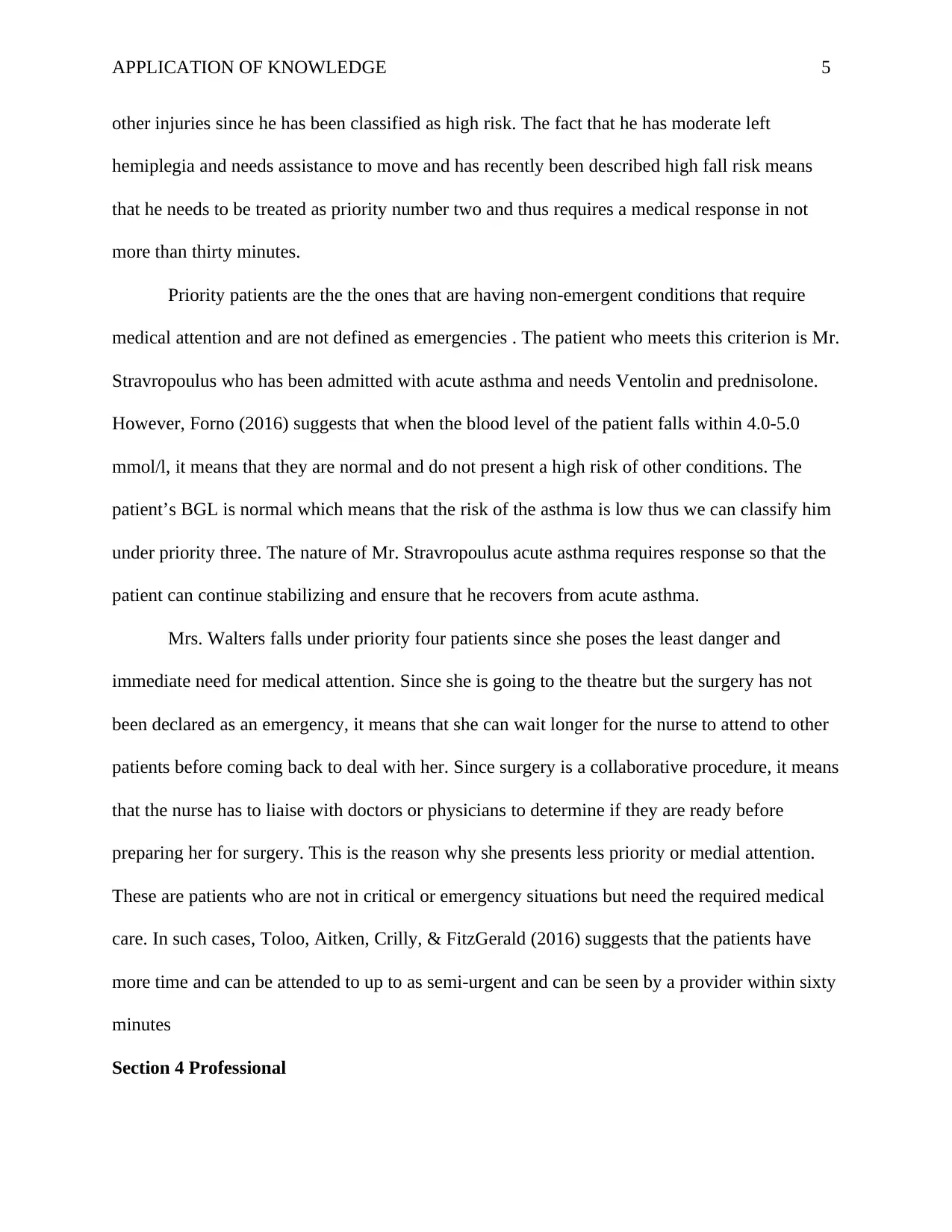
APPLICATION OF KNOWLEDGE 5
other injuries since he has been classified as high risk. The fact that he has moderate left
hemiplegia and needs assistance to move and has recently been described high fall risk means
that he needs to be treated as priority number two and thus requires a medical response in not
more than thirty minutes.
Priority patients are the the ones that are having non-emergent conditions that require
medical attention and are not defined as emergencies . The patient who meets this criterion is Mr.
Stravropoulus who has been admitted with acute asthma and needs Ventolin and prednisolone.
However, Forno (2016) suggests that when the blood level of the patient falls within 4.0-5.0
mmol/l, it means that they are normal and do not present a high risk of other conditions. The
patient’s BGL is normal which means that the risk of the asthma is low thus we can classify him
under priority three. The nature of Mr. Stravropoulus acute asthma requires response so that the
patient can continue stabilizing and ensure that he recovers from acute asthma.
Mrs. Walters falls under priority four patients since she poses the least danger and
immediate need for medical attention. Since she is going to the theatre but the surgery has not
been declared as an emergency, it means that she can wait longer for the nurse to attend to other
patients before coming back to deal with her. Since surgery is a collaborative procedure, it means
that the nurse has to liaise with doctors or physicians to determine if they are ready before
preparing her for surgery. This is the reason why she presents less priority or medial attention.
These are patients who are not in critical or emergency situations but need the required medical
care. In such cases, Toloo, Aitken, Crilly, & FitzGerald (2016) suggests that the patients have
more time and can be attended to up to as semi-urgent and can be seen by a provider within sixty
minutes
Section 4 Professional
other injuries since he has been classified as high risk. The fact that he has moderate left
hemiplegia and needs assistance to move and has recently been described high fall risk means
that he needs to be treated as priority number two and thus requires a medical response in not
more than thirty minutes.
Priority patients are the the ones that are having non-emergent conditions that require
medical attention and are not defined as emergencies . The patient who meets this criterion is Mr.
Stravropoulus who has been admitted with acute asthma and needs Ventolin and prednisolone.
However, Forno (2016) suggests that when the blood level of the patient falls within 4.0-5.0
mmol/l, it means that they are normal and do not present a high risk of other conditions. The
patient’s BGL is normal which means that the risk of the asthma is low thus we can classify him
under priority three. The nature of Mr. Stravropoulus acute asthma requires response so that the
patient can continue stabilizing and ensure that he recovers from acute asthma.
Mrs. Walters falls under priority four patients since she poses the least danger and
immediate need for medical attention. Since she is going to the theatre but the surgery has not
been declared as an emergency, it means that she can wait longer for the nurse to attend to other
patients before coming back to deal with her. Since surgery is a collaborative procedure, it means
that the nurse has to liaise with doctors or physicians to determine if they are ready before
preparing her for surgery. This is the reason why she presents less priority or medial attention.
These are patients who are not in critical or emergency situations but need the required medical
care. In such cases, Toloo, Aitken, Crilly, & FitzGerald (2016) suggests that the patients have
more time and can be attended to up to as semi-urgent and can be seen by a provider within sixty
minutes
Section 4 Professional
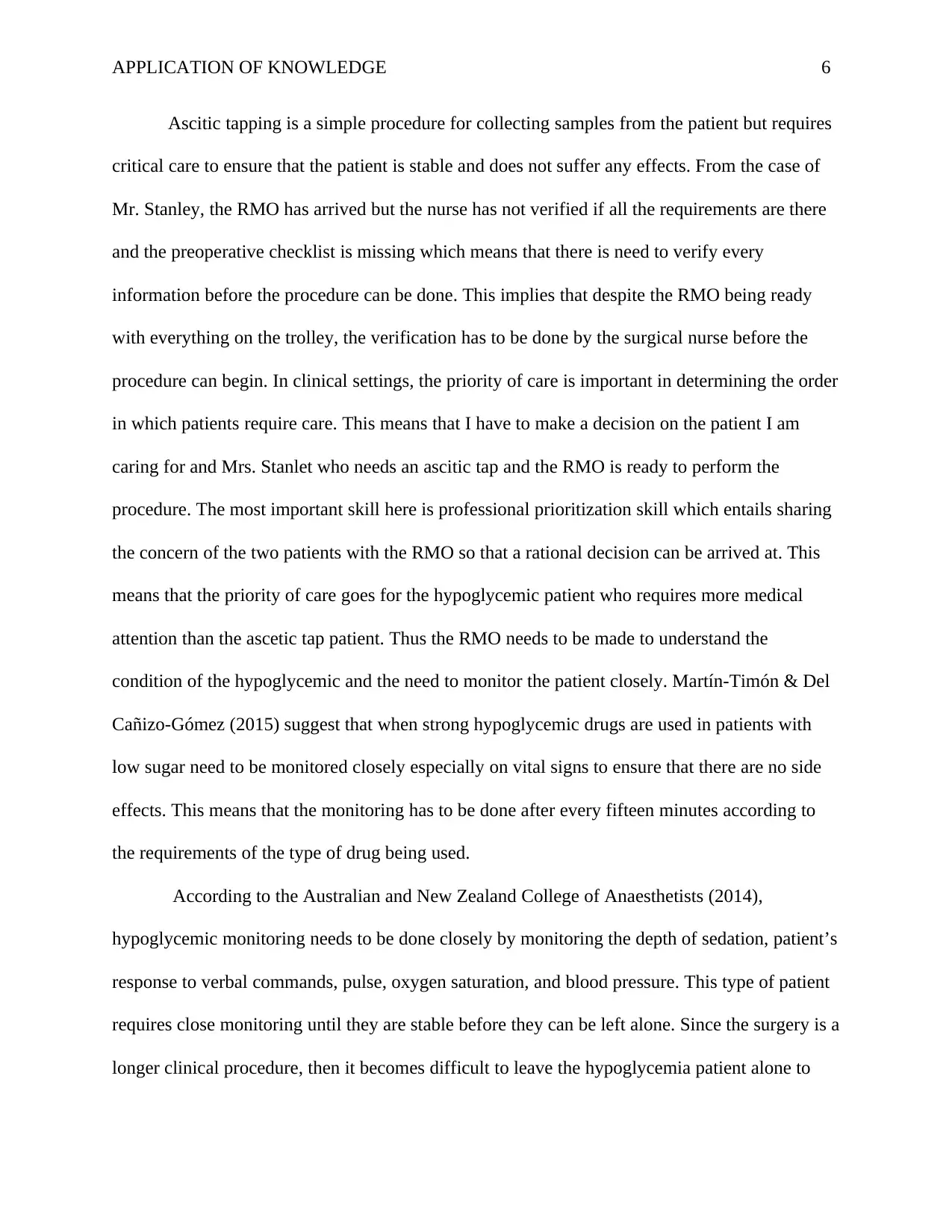
APPLICATION OF KNOWLEDGE 6
Ascitic tapping is a simple procedure for collecting samples from the patient but requires
critical care to ensure that the patient is stable and does not suffer any effects. From the case of
Mr. Stanley, the RMO has arrived but the nurse has not verified if all the requirements are there
and the preoperative checklist is missing which means that there is need to verify every
information before the procedure can be done. This implies that despite the RMO being ready
with everything on the trolley, the verification has to be done by the surgical nurse before the
procedure can begin. In clinical settings, the priority of care is important in determining the order
in which patients require care. This means that I have to make a decision on the patient I am
caring for and Mrs. Stanlet who needs an ascitic tap and the RMO is ready to perform the
procedure. The most important skill here is professional prioritization skill which entails sharing
the concern of the two patients with the RMO so that a rational decision can be arrived at. This
means that the priority of care goes for the hypoglycemic patient who requires more medical
attention than the ascetic tap patient. Thus the RMO needs to be made to understand the
condition of the hypoglycemic and the need to monitor the patient closely. Martín-Timón & Del
Cañizo-Gómez (2015) suggest that when strong hypoglycemic drugs are used in patients with
low sugar need to be monitored closely especially on vital signs to ensure that there are no side
effects. This means that the monitoring has to be done after every fifteen minutes according to
the requirements of the type of drug being used.
According to the Australian and New Zealand College of Anaesthetists (2014),
hypoglycemic monitoring needs to be done closely by monitoring the depth of sedation, patient’s
response to verbal commands, pulse, oxygen saturation, and blood pressure. This type of patient
requires close monitoring until they are stable before they can be left alone. Since the surgery is a
longer clinical procedure, then it becomes difficult to leave the hypoglycemia patient alone to
Ascitic tapping is a simple procedure for collecting samples from the patient but requires
critical care to ensure that the patient is stable and does not suffer any effects. From the case of
Mr. Stanley, the RMO has arrived but the nurse has not verified if all the requirements are there
and the preoperative checklist is missing which means that there is need to verify every
information before the procedure can be done. This implies that despite the RMO being ready
with everything on the trolley, the verification has to be done by the surgical nurse before the
procedure can begin. In clinical settings, the priority of care is important in determining the order
in which patients require care. This means that I have to make a decision on the patient I am
caring for and Mrs. Stanlet who needs an ascitic tap and the RMO is ready to perform the
procedure. The most important skill here is professional prioritization skill which entails sharing
the concern of the two patients with the RMO so that a rational decision can be arrived at. This
means that the priority of care goes for the hypoglycemic patient who requires more medical
attention than the ascetic tap patient. Thus the RMO needs to be made to understand the
condition of the hypoglycemic and the need to monitor the patient closely. Martín-Timón & Del
Cañizo-Gómez (2015) suggest that when strong hypoglycemic drugs are used in patients with
low sugar need to be monitored closely especially on vital signs to ensure that there are no side
effects. This means that the monitoring has to be done after every fifteen minutes according to
the requirements of the type of drug being used.
According to the Australian and New Zealand College of Anaesthetists (2014),
hypoglycemic monitoring needs to be done closely by monitoring the depth of sedation, patient’s
response to verbal commands, pulse, oxygen saturation, and blood pressure. This type of patient
requires close monitoring until they are stable before they can be left alone. Since the surgery is a
longer clinical procedure, then it becomes difficult to leave the hypoglycemia patient alone to
⊘ This is a preview!⊘
Do you want full access?
Subscribe today to unlock all pages.

Trusted by 1+ million students worldwide
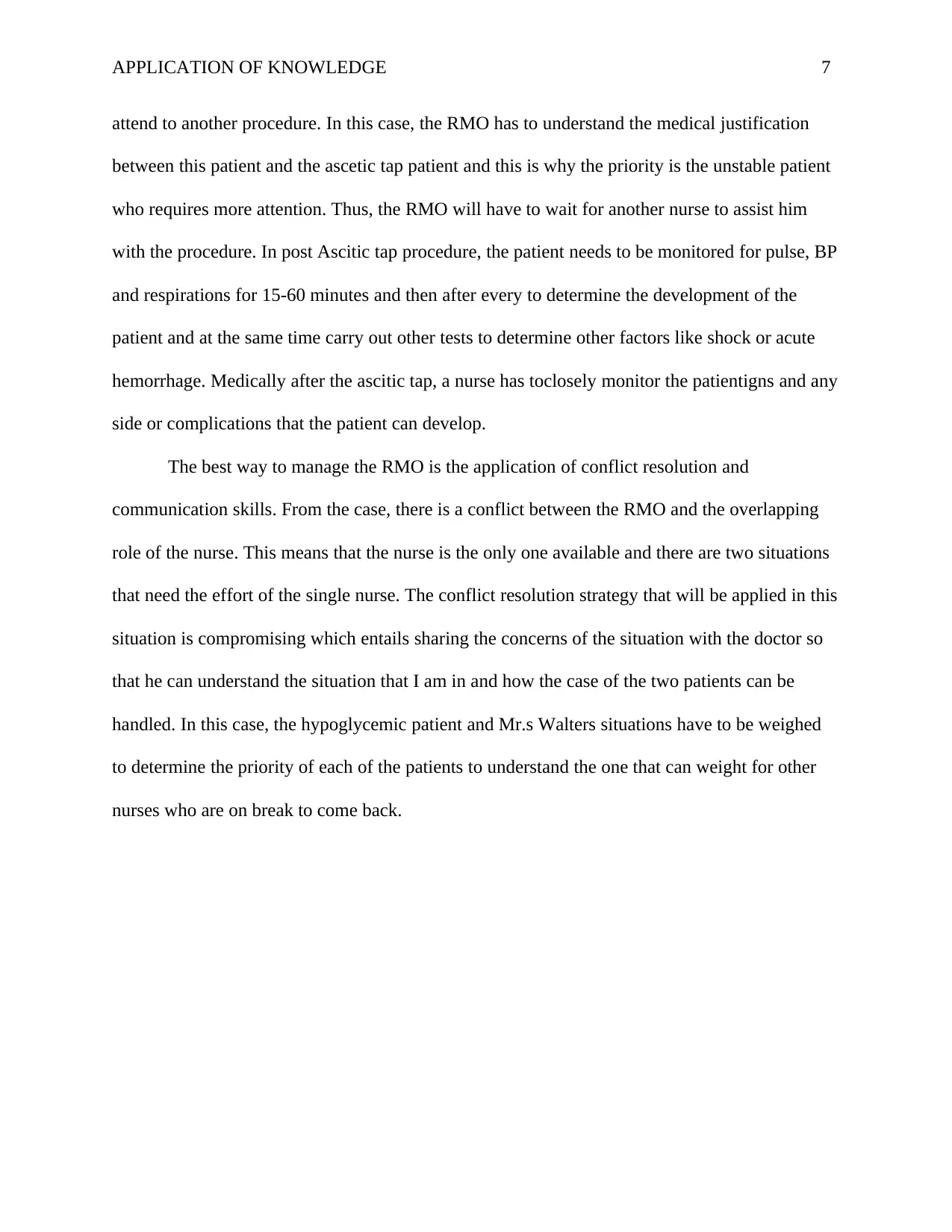
APPLICATION OF KNOWLEDGE 7
attend to another procedure. In this case, the RMO has to understand the medical justification
between this patient and the ascetic tap patient and this is why the priority is the unstable patient
who requires more attention. Thus, the RMO will have to wait for another nurse to assist him
with the procedure. In post Ascitic tap procedure, the patient needs to be monitored for pulse, BP
and respirations for 15-60 minutes and then after every to determine the development of the
patient and at the same time carry out other tests to determine other factors like shock or acute
hemorrhage. Medically after the ascitic tap, a nurse has toclosely monitor the patientigns and any
side or complications that the patient can develop.
The best way to manage the RMO is the application of conflict resolution and
communication skills. From the case, there is a conflict between the RMO and the overlapping
role of the nurse. This means that the nurse is the only one available and there are two situations
that need the effort of the single nurse. The conflict resolution strategy that will be applied in this
situation is compromising which entails sharing the concerns of the situation with the doctor so
that he can understand the situation that I am in and how the case of the two patients can be
handled. In this case, the hypoglycemic patient and Mr.s Walters situations have to be weighed
to determine the priority of each of the patients to understand the one that can weight for other
nurses who are on break to come back.
attend to another procedure. In this case, the RMO has to understand the medical justification
between this patient and the ascetic tap patient and this is why the priority is the unstable patient
who requires more attention. Thus, the RMO will have to wait for another nurse to assist him
with the procedure. In post Ascitic tap procedure, the patient needs to be monitored for pulse, BP
and respirations for 15-60 minutes and then after every to determine the development of the
patient and at the same time carry out other tests to determine other factors like shock or acute
hemorrhage. Medically after the ascitic tap, a nurse has toclosely monitor the patientigns and any
side or complications that the patient can develop.
The best way to manage the RMO is the application of conflict resolution and
communication skills. From the case, there is a conflict between the RMO and the overlapping
role of the nurse. This means that the nurse is the only one available and there are two situations
that need the effort of the single nurse. The conflict resolution strategy that will be applied in this
situation is compromising which entails sharing the concerns of the situation with the doctor so
that he can understand the situation that I am in and how the case of the two patients can be
handled. In this case, the hypoglycemic patient and Mr.s Walters situations have to be weighed
to determine the priority of each of the patients to understand the one that can weight for other
nurses who are on break to come back.
Paraphrase This Document
Need a fresh take? Get an instant paraphrase of this document with our AI Paraphraser
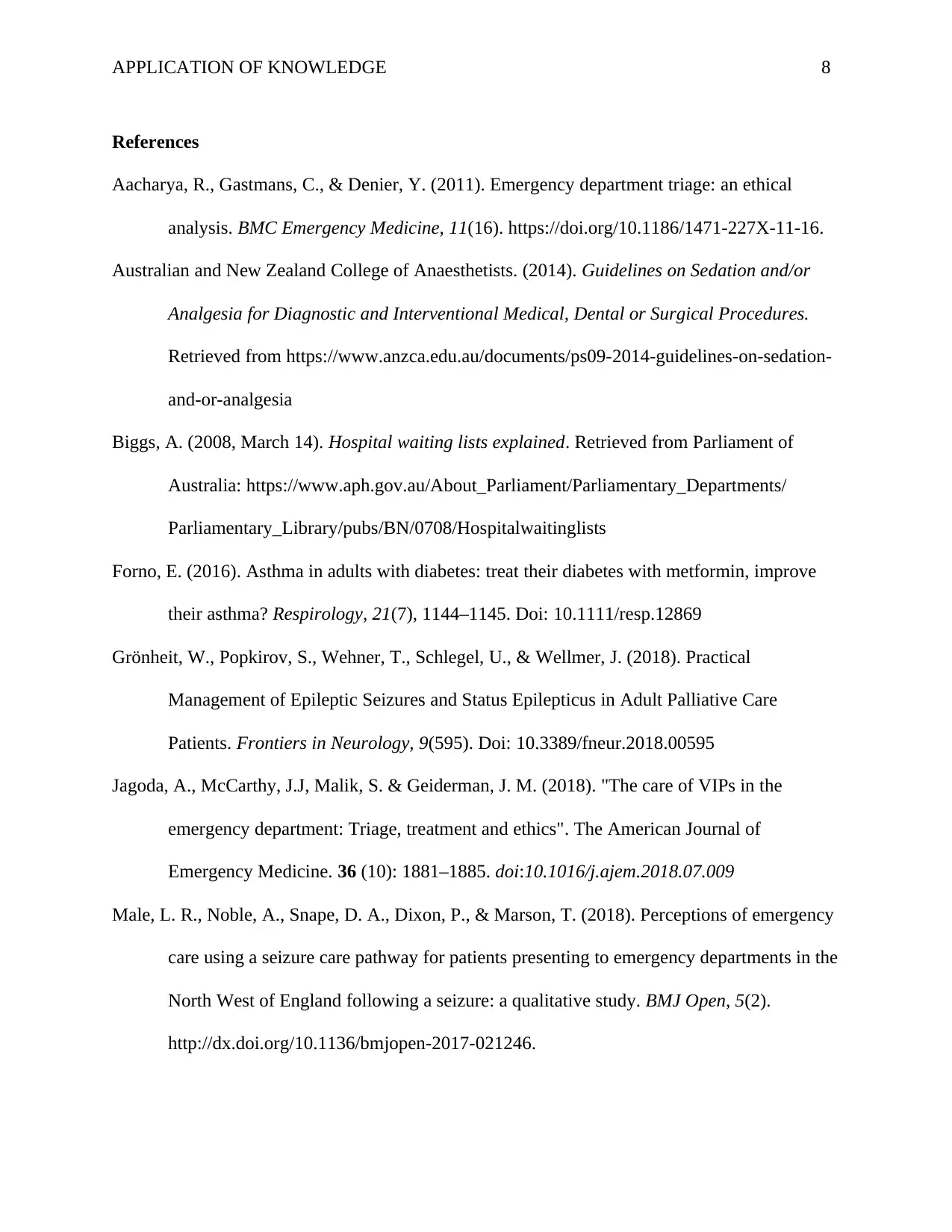
APPLICATION OF KNOWLEDGE 8
References
Aacharya, R., Gastmans, C., & Denier, Y. (2011). Emergency department triage: an ethical
analysis. BMC Emergency Medicine, 11(16). https://doi.org/10.1186/1471-227X-11-16.
Australian and New Zealand College of Anaesthetists. (2014). Guidelines on Sedation and/or
Analgesia for Diagnostic and Interventional Medical, Dental or Surgical Procedures.
Retrieved from https://www.anzca.edu.au/documents/ps09-2014-guidelines-on-sedation-
and-or-analgesia
Biggs, A. (2008, March 14). Hospital waiting lists explained. Retrieved from Parliament of
Australia: https://www.aph.gov.au/About_Parliament/Parliamentary_Departments/
Parliamentary_Library/pubs/BN/0708/Hospitalwaitinglists
Forno, E. (2016). Asthma in adults with diabetes: treat their diabetes with metformin, improve
their asthma? Respirology, 21(7), 1144–1145. Doi: 10.1111/resp.12869
Grönheit, W., Popkirov, S., Wehner, T., Schlegel, U., & Wellmer, J. (2018). Practical
Management of Epileptic Seizures and Status Epilepticus in Adult Palliative Care
Patients. Frontiers in Neurology, 9(595). Doi: 10.3389/fneur.2018.00595
Jagoda, A., McCarthy, J.J, Malik, S. & Geiderman, J. M. (2018). "The care of VIPs in the
emergency department: Triage, treatment and ethics". The American Journal of
Emergency Medicine. 36 (10): 1881–1885. doi:10.1016/j.ajem.2018.07.009
Male, L. R., Noble, A., Snape, D. A., Dixon, P., & Marson, T. (2018). Perceptions of emergency
care using a seizure care pathway for patients presenting to emergency departments in the
North West of England following a seizure: a qualitative study. BMJ Open, 5(2).
http://dx.doi.org/10.1136/bmjopen-2017-021246.
References
Aacharya, R., Gastmans, C., & Denier, Y. (2011). Emergency department triage: an ethical
analysis. BMC Emergency Medicine, 11(16). https://doi.org/10.1186/1471-227X-11-16.
Australian and New Zealand College of Anaesthetists. (2014). Guidelines on Sedation and/or
Analgesia for Diagnostic and Interventional Medical, Dental or Surgical Procedures.
Retrieved from https://www.anzca.edu.au/documents/ps09-2014-guidelines-on-sedation-
and-or-analgesia
Biggs, A. (2008, March 14). Hospital waiting lists explained. Retrieved from Parliament of
Australia: https://www.aph.gov.au/About_Parliament/Parliamentary_Departments/
Parliamentary_Library/pubs/BN/0708/Hospitalwaitinglists
Forno, E. (2016). Asthma in adults with diabetes: treat their diabetes with metformin, improve
their asthma? Respirology, 21(7), 1144–1145. Doi: 10.1111/resp.12869
Grönheit, W., Popkirov, S., Wehner, T., Schlegel, U., & Wellmer, J. (2018). Practical
Management of Epileptic Seizures and Status Epilepticus in Adult Palliative Care
Patients. Frontiers in Neurology, 9(595). Doi: 10.3389/fneur.2018.00595
Jagoda, A., McCarthy, J.J, Malik, S. & Geiderman, J. M. (2018). "The care of VIPs in the
emergency department: Triage, treatment and ethics". The American Journal of
Emergency Medicine. 36 (10): 1881–1885. doi:10.1016/j.ajem.2018.07.009
Male, L. R., Noble, A., Snape, D. A., Dixon, P., & Marson, T. (2018). Perceptions of emergency
care using a seizure care pathway for patients presenting to emergency departments in the
North West of England following a seizure: a qualitative study. BMJ Open, 5(2).
http://dx.doi.org/10.1136/bmjopen-2017-021246.
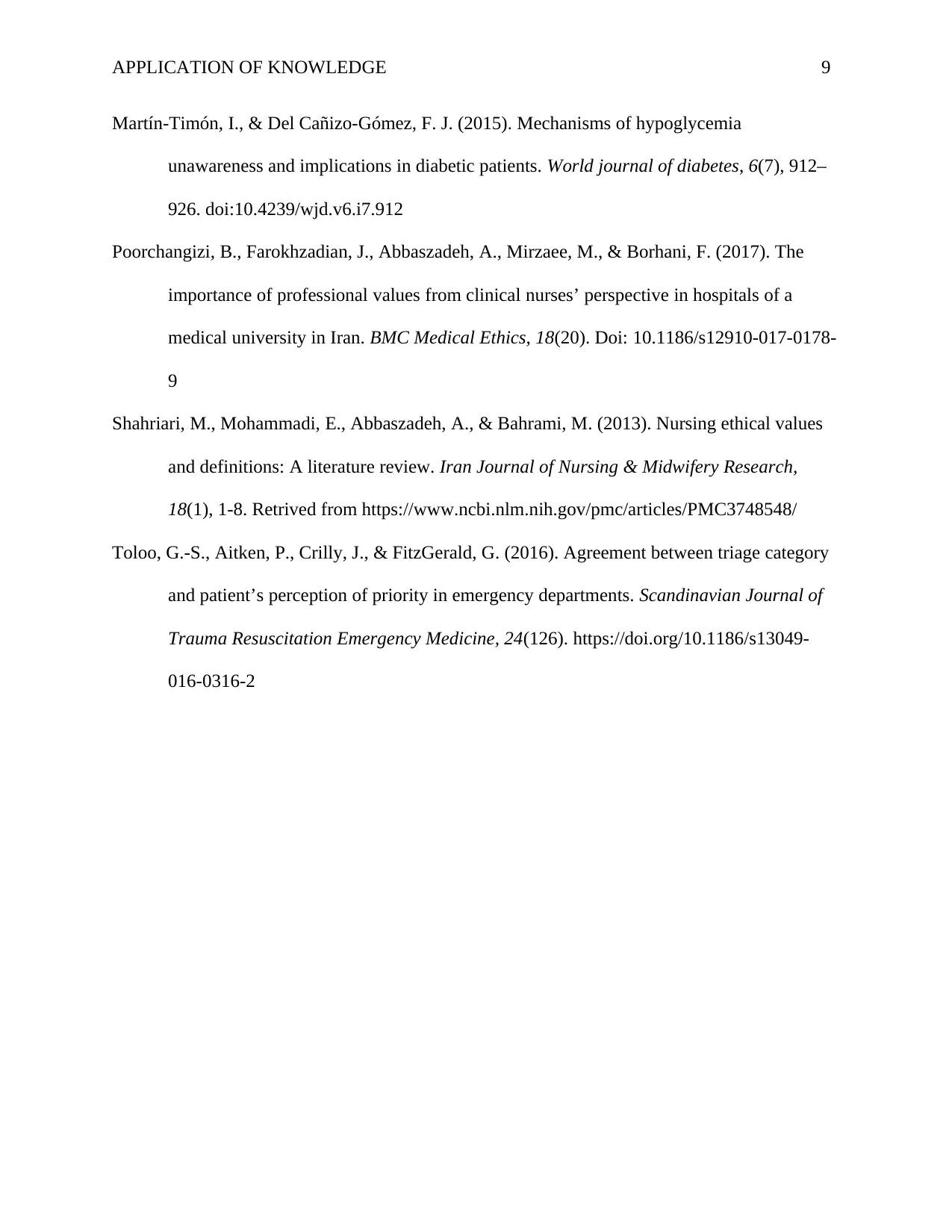
APPLICATION OF KNOWLEDGE 9
Martín-Timón, I., & Del Cañizo-Gómez, F. J. (2015). Mechanisms of hypoglycemia
unawareness and implications in diabetic patients. World journal of diabetes, 6(7), 912–
926. doi:10.4239/wjd.v6.i7.912
Poorchangizi, B., Farokhzadian, J., Abbaszadeh, A., Mirzaee, M., & Borhani, F. (2017). The
importance of professional values from clinical nurses’ perspective in hospitals of a
medical university in Iran. BMC Medical Ethics, 18(20). Doi: 10.1186/s12910-017-0178-
9
Shahriari, M., Mohammadi, E., Abbaszadeh, A., & Bahrami, M. (2013). Nursing ethical values
and definitions: A literature review. Iran Journal of Nursing & Midwifery Research,
18(1), 1-8. Retrived from https://www.ncbi.nlm.nih.gov/pmc/articles/PMC3748548/
Toloo, G.-S., Aitken, P., Crilly, J., & FitzGerald, G. (2016). Agreement between triage category
and patient’s perception of priority in emergency departments. Scandinavian Journal of
Trauma Resuscitation Emergency Medicine, 24(126). https://doi.org/10.1186/s13049-
016-0316-2
Martín-Timón, I., & Del Cañizo-Gómez, F. J. (2015). Mechanisms of hypoglycemia
unawareness and implications in diabetic patients. World journal of diabetes, 6(7), 912–
926. doi:10.4239/wjd.v6.i7.912
Poorchangizi, B., Farokhzadian, J., Abbaszadeh, A., Mirzaee, M., & Borhani, F. (2017). The
importance of professional values from clinical nurses’ perspective in hospitals of a
medical university in Iran. BMC Medical Ethics, 18(20). Doi: 10.1186/s12910-017-0178-
9
Shahriari, M., Mohammadi, E., Abbaszadeh, A., & Bahrami, M. (2013). Nursing ethical values
and definitions: A literature review. Iran Journal of Nursing & Midwifery Research,
18(1), 1-8. Retrived from https://www.ncbi.nlm.nih.gov/pmc/articles/PMC3748548/
Toloo, G.-S., Aitken, P., Crilly, J., & FitzGerald, G. (2016). Agreement between triage category
and patient’s perception of priority in emergency departments. Scandinavian Journal of
Trauma Resuscitation Emergency Medicine, 24(126). https://doi.org/10.1186/s13049-
016-0316-2
⊘ This is a preview!⊘
Do you want full access?
Subscribe today to unlock all pages.

Trusted by 1+ million students worldwide
1 out of 9
Related Documents
Your All-in-One AI-Powered Toolkit for Academic Success.
+13062052269
info@desklib.com
Available 24*7 on WhatsApp / Email
![[object Object]](/_next/static/media/star-bottom.7253800d.svg)
Unlock your academic potential
Copyright © 2020–2025 A2Z Services. All Rights Reserved. Developed and managed by ZUCOL.




